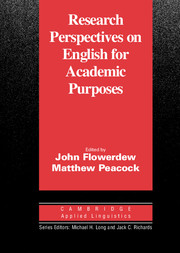Book contents
- Frontmatter
- Contents
- List of contributors
- Series editors' preface
- Preface
- I ISSUES IN ENGLISH FOR ACADEMIC PURPOSES
- II THE ENGLISH FOR ACADEMIC PURPOSES CURRICULUM
- Introduction to Part II
- 11 The EAP curriculum: Issues, methods, and challenges
- 12 Twenty years of needs analyses: Reflections on a personal journey
- 13 The curriculum renewal process in English for academic purposes programmes
- 14 Team-teaching in EAP: Changes and adaptations in the Birmingham approach
- 15 Does the emperor have no clothes? A re-examination of grammar in content-based instruction
- 16 The specialised vocabulary of English for academic purposes
- 17 Language learning strategies and EAP proficiency: Teacher views, student views, and test results
- 18 Issues in EAP test development: What one institution and its history tell us
- 19 Teaching writing for academic purposes
- 20 Reading academic English: Carrying learners across the lexical threshold
- 21 Incorporating reading into EAP writing courses
- 22 The development of EAP oral discussion ability
- 23 Second language lecture comprehension research in naturalistic controlled conditions
- 24 Designing tasks for developing study competence and study skills in English
- 25 Promoting EAP learner autonomy in a second language university context
- References
- Index
21 - Incorporating reading into EAP writing courses
Published online by Cambridge University Press: 05 October 2012
- Frontmatter
- Contents
- List of contributors
- Series editors' preface
- Preface
- I ISSUES IN ENGLISH FOR ACADEMIC PURPOSES
- II THE ENGLISH FOR ACADEMIC PURPOSES CURRICULUM
- Introduction to Part II
- 11 The EAP curriculum: Issues, methods, and challenges
- 12 Twenty years of needs analyses: Reflections on a personal journey
- 13 The curriculum renewal process in English for academic purposes programmes
- 14 Team-teaching in EAP: Changes and adaptations in the Birmingham approach
- 15 Does the emperor have no clothes? A re-examination of grammar in content-based instruction
- 16 The specialised vocabulary of English for academic purposes
- 17 Language learning strategies and EAP proficiency: Teacher views, student views, and test results
- 18 Issues in EAP test development: What one institution and its history tell us
- 19 Teaching writing for academic purposes
- 20 Reading academic English: Carrying learners across the lexical threshold
- 21 Incorporating reading into EAP writing courses
- 22 The development of EAP oral discussion ability
- 23 Second language lecture comprehension research in naturalistic controlled conditions
- 24 Designing tasks for developing study competence and study skills in English
- 25 Promoting EAP learner autonomy in a second language university context
- References
- Index
Summary
Introduction
While reading has been an especially rich area of research for both L1 and L2 reading specialists over the past three decades and has produced a wealth of valuable studies and insights, it remains an enigma for reading researchers. For all we now know about reading, it is still, says Mackey (1997), an experience that is ‘complex, untidy, and inevitably partial’ (p. 428) as well as ‘invisible and private’ (p. 430).
These observations are particularly important with respect to the reading practices and experiences of L2 readers, as well as to researchers' and teachers' quest to understand those practices and experiences better. Reading in a second language is clearly a complex and difficult undertaking for many students, plus, as Carson and Leki (1993b) have stated, ‘reading can be, and in academic settings nearly always is, the basis for writing’ (p. 1). In particular, university students frequently perform the act of composing from source texts. Hence, as Spack (1988) has indicated, ‘perhaps the most important skill English teachers can engage students in is the complex ability to write from other texts, a major part of their academic writing experience’ (p. 42). Thus, Grabe (1991) sees the need for ‘reading and writing to be taught together in advanced academic preparation’ (p. 395). Meanwhile, students having writing problems may actually be experiencing reading problems. The act of composing from sources starts with the reading of those texts.
- Type
- Chapter
- Information
- Research Perspectives on English for Academic Purposes , pp. 330 - 346Publisher: Cambridge University PressPrint publication year: 2001
- 6
- Cited by

